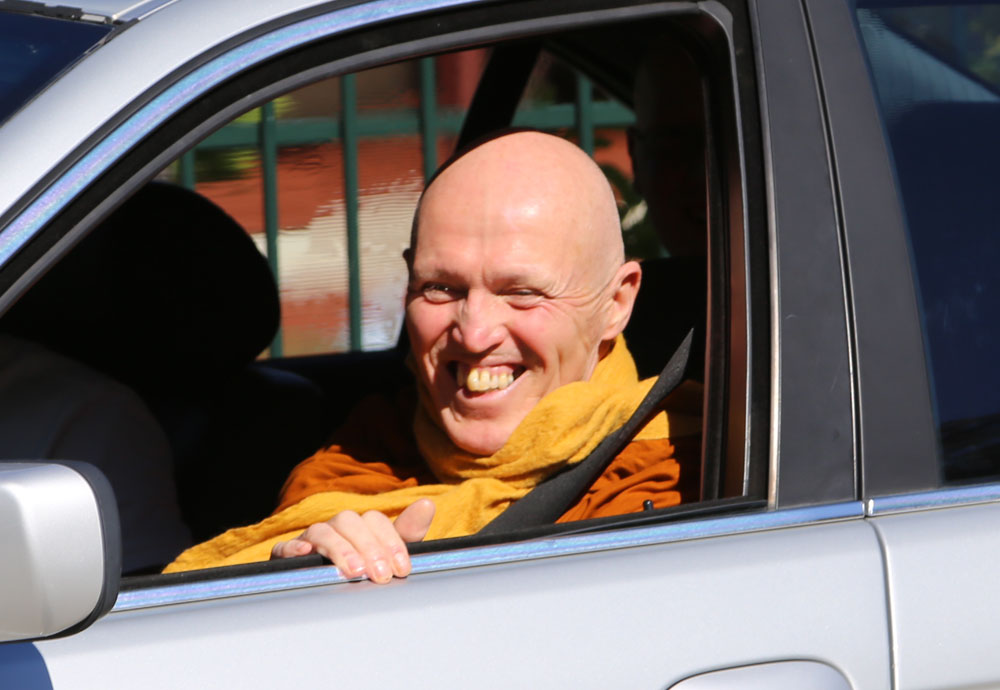More to Wake Up to
 After reading Jeanne Theoharis’ sobering op-ed in the New York Times, What King Said About Northern Liberalism, my CDL Waking Up to Whiteness group has selected for our next discussion Theoharis’ A More Beautiful and Terrible History: The Uses and Misuses of Civil Rights History.
After reading Jeanne Theoharis’ sobering op-ed in the New York Times, What King Said About Northern Liberalism, my CDL Waking Up to Whiteness group has selected for our next discussion Theoharis’ A More Beautiful and Terrible History: The Uses and Misuses of Civil Rights History.
From the publisher: “The civil rights movement has become national legend, lauded by presidents from Reagan to Obama to Trump, as proof of the power of American democracy.
“This fable, featuring dreamy heroes and accidental heroines, has shuttered the movement firmly in the past, whitewashed the forces that stood in its way, and diminished its scope. And it is used perniciously in our own times to chastise present-day movements and obscure contemporary injustice.
“In A More Beautiful and Terrible History award-winning historian Jeanne Theoharis dissects this national myth-making, teasing apart the accepted stories to show them in a strikingly different light.”
***
I expect this will not be an easy read, but I feel ready for it. How about you?
There’s a Quality of Happiness…
Ajahn Sucitto: “The manifestation experience of faith is the ah-ha moment when something in you opens up… Something happens in the mind…
“Something shifts. Something tingles. Something urges. Something vibrates. Something resonates…
“It’s a time when we experience ourselves as being deeply alive. In ourselves. Intimately alive.
“Not lit up by some obsession. Not lit up by something happening. Not lit up by, you know, praise and success and so forth, but somehow quietly illuminated in presence…
“There’s a quality of the happiness that’s the happiness of taking a weight off your back. Not the happiness of burrowing into something, but the happiness of ahhhhhhhhh. Taking off the burden.
“These are not often of long duration, these realization moments, and that burden can be the burden of one’s constant need to be something. Constant need to be running forward. Constant need to be succeeding. Constant need to be approved of, or something that’s just — uhh, I’ve had enough! — and that — that’s fantastic.”
***
The photo above is of Ajahn Sucitto. The excerpt above is taken from his talk on Intention and Effort, starting at about the 43 minute mark. (But listen to it all, beginning to end, to really get what he’s talking about.) Enjoy!
The Ability to Pour Forth
Ajahn Sucitto: “Another very important quality of heart — we sense this as an aspect of what we might call love — is the ability to pour forth, to bring forth, to give.
“We can do this in our work: we want to really give ourselves to something we really care for or are interested in. Or to another person, to give to a child or to a partner: we want to really offer something from ourselves.
“And in puja [spiritual devotion] or in making commitments to one’s spiritual training or one’s practice: you really want to give yourself to the sacred — however that’s configured.
“And that’s quite important. To actually extend the range of that. So we give ourself to our duties, to our relationships, and even to the earth — how can we support, look after, and care for the earth — and to the sacred.
“So: How do I offer myself, open my mind, open my heart — to truth, virtue, beauty, clarity, purity…to those resonances.
“Can I reach to that range, which is ungraspable.
“If it’s graspable, it turns into dogmatism, believe systems.
“If it’s left un-grasped, it turns into this infinite opening of heart. It’s a very beautiful form of spiritual love.
“This is something definitely to get a handle on, to train in. Because it’s for one’s deep fulfillment — this pouring one’s self into.
“We long to do that. For most people this is expressed in one’s vocation. Or in their relationships. Or in their parenting. Or even in the way they look after a piece of land or something. They empty themselves into that.
“And there’s a lovely richness in that. We don’t lose, we are actually gained by the giving, enriched by the giving.
“This is a very important feature of practice.”
***
(from this talk by Ajahn Sucitto, beginning at about the 25 minute mark)
Metta is…
Since this is my Year of Getting to Know Goodwill, I am taking note when Ajahn Sucitto, in a recent talk at the Forest Refuge, described metta as “that which inclines toward nourishing.”
I don’t think I’ve ever heard it put quite like that before.
Kind of gives it a different flavor, doesn’t it!
***
(quote from 11/11/18 Q&A session, beginning at about the 27 minute mark — click here to listen.)
Introducing: Study and Practice Class
 Beginning March 5, I will offer a 6-week Study and Practice class on the Buddha’s foundational instructions for meditation practice — the Satipatthana Sutta.
Beginning March 5, I will offer a 6-week Study and Practice class on the Buddha’s foundational instructions for meditation practice — the Satipatthana Sutta.
Although not required reading, we will use Bhikkhu Analayo’s Satipatthana Meditation: A Practice Guide as our reference text.
This is an intermediate-level class, suitable for practitioners who are interested in going beyond the basics of Mindfulness of Breathing.
The course will include instruction in:
* Mindfulness of Body (including Breathing and Four Elements contemplation)
* Mindfulness of Feeling Tone (Pleasant, Unpleasant, Neutral)
* Mindfulness of Mind States (Thoughts and Emotions)
* Mindfulness of Categories of Experience (Hindrances and Enlightenment Factors)
***
When: Tuesday evenings, 7:00 pm to 8:30 pm, March 5-April 9
Where: First Unitarian Church of St. Louis, 5007 Waterman
What: Each session will include a silent 30-minute sit as well as meditation instructions, discussion, and Q&A.
Cost: The teachings will be offered on a dana (donation) basis, but there is a $20 fee to register.
Interested? Email me here.
***
My teaching credentials: I have completed four years of training through Spirit Rock, where I am certified as a Community Dharma Leader. I’ve practiced in the Western Insight tradition for 20 years with a variety of teachers including Jack Kornfield, Joseph Goldstein, and Sharon Salzberg — and Bhikkhu Analayo. I’ve spent more than 450 days on silent retreat including several 1- and 2-month intensive retreats in the U.S., South Africa, and Burma (Myanmar). My primary teacher is Phillip Moffitt.
It’s SUPPOSED to Feel Good
When asked to discuss the role of delight on the Buddhist path, when it should be cultivated, and when let go of, here’s what Ajahn Sucitto had to say:
“Well, there are many words that are used in the Buddhist lexicon, but I image that what the questioner is talking about is something like rapture and happiness — piti and sukha.
“This is to be cultivated in order to counteract the hindrances — the effects of the hindrances, the traces of the hindrances.
“We can imagine that the citta [heat/mind] will flow down the most predominant tracks, the most deeply etched tracks, like a fluid will run down the tracks that are most deeply engraved, that are most habitual. So if our habitual tendency is worry, or negativity, or cynicism, or self-criticism, then the citta easily runs down that. At the drop of a hat, it rushes down it.
“When we meditate, we are deliberately blocking those channels, or turning away from those channels, and developing other channels. So, with puja [devotional rituals], sila [ethical behavior], metta [goodwill], dana [generosity] — all that — composure, breathing in and breathing out, and so forth — we are developing other things.
“Those qualities become authorized by pleasure.
“We are quite simple creatures, really. We follow what’s pleasant. So, pleasure gives authority. We obey pleasure. And we obey pain.
“So when we begin to recognize qualities that give a sense of pleasure that is skillful, that we feel no regret around, that doesn’t gives us hangovers or burn-outs or harm anybody or cost anything — then, we go for it.
“And then the citta begins to get reset from these negative kamma [actions] to agreeable kamma. Agreeable kamma has good feeling associated with it.
“Agreeable kamma feels good. It’s not just morally correct. It feels good. And it’s important to recognize the feel-good quality of it. It’s not just correct. It should feel good.
“If it doesn’t feel good, you haven’t really embedded in it yet, you haven’t really drunk it in yet, you haven’t made use of it. You should absorb it — till it makes you feel GOOD.
“Then it’s going to gain authority.
“So reflect a lot and wisely attend to skillfulness. Take it into the heart. How’s this feel? To avoid harming, to put aside cruelty, doesn’t that give you dignity, value, self-respect? Isn’t that good? Doesn’t that feel good?
“So we meditate — and part of the aim of meditation is to feel good. To feel these qualities of calm, and ease, and absence of pressure, and simplicity, freedom from obstructions… This is supposed to feel good! To make you happy!
“If you haven’t looked at that aspect of it, then you have deprived yourself of one of the main aims. Because the pleasant feeling definitely creates a momentum so that the citta will then go there. And then it loses track, it loses touch with the negative kamma. Gross negativity, that is. Those tendencies dry up. Because it’s gone the other way.
“This is the point of piti and sukha. These are embodied qualities. And the body itself begins to release some of its tensions, its somatic distortions. We can feel trapped in our chest or locked into our bellies or shut down in our throats. Then that starts to peel off. And you feel VERY NICE.
“And it’s skillful.
“It should not be ‘let go of.’ Nothing is ‘let go of.’ Things become unnecessary. They fall off when they’re no longer needed.
“Letting go is not an action that you do. It’s something that occurs when: that’s finished; that’s enough of that.
“Then this quality of piti/sukha, when it’s done its work, strangely enough, something in the citta feels: I’d like to be just a little bit quieter. Yeah, that’d be nice. Just a little quieter. Yeah. Nice….
“So then the pleasure subsides. Into something more equanimous.
“OK. I think that’s enough for tonight.”
🙂
***
The above excerpt is from this talk, beginning at about the 48 minute mark.
What Feeds the Heart?
Hint — Not this:
Here’s what Ajahn Sucitto’s says:
“Renunciation — nekamma. Kamma is a word that has to do with the senses, the external senses, the sense doors. Nekamma is the movement away from feeding on senses — eyes, ears, nose, tongue, body. This is an inclination that occurs as one begins to feel the richness of food for the heart — such as kindness, goodwill, gratitude, generosity, virtue, etc. — you start to feel satisfied, fed, enriched by that. Therefore, sense contact really isn’t such a big deal. It doesn’t quite ‘hit the mark’ in the same way that these heart qualities do.
“Because the citta cannot feed on the senses. It feeds on the feelings, the metal perceptions, that arise from the senses. The interpretations of it. So we see something that signifies as attractive or delightful, but actually the eye doesn’t do that. The eye just sees something and the mind infers beauty or attractiveness or desirability in it.
“The mind creates a kind of ‘glow’ perception. There’s a particular ‘glow’ that occurs. That’s mental. Deriving from the sense contact, there’s a triggering of this kind of ‘glow’ that occurs when we see a cinnamon bun, or something.
“But you know you can’t actually pack a cinnamon bun into your mind. So you put it into your mouth. And it doesn’t last. And it probably doesn’t quite do exactly what the ‘glow’ said it would do.
“If you track the process you begin to get it. It’s actually not the sight, not the object itself, but it’s the particular kindling of a delight quality — that’s what the citta likes. It wants that. But it’s actually quite brief when it comes dependent on sense contact. It’s relatively brief. It’s a sort of ‘flare.’ And actually, after the fifth cinnamon bun, it doesn’t occur at all.
“So then we have something else. It can go on like that. Because the ‘glow’ can move from one place to another. The citta feeds on that ‘glow’ as best it can.
“Now, there’s actually a deeper, warming effect that is richer food, that is generated through the citta itself. This is called: Happiness which is born of withdrawal from unskillful states.
“So whenever there’s a withdrawal from hatred, greed, malice, jealousy, fear, bitterness, worry, doubt, etc., the citta feels: Ooooh, that’s nice! There’s the subtle quality of that.
“Then if that quality is tuned into, is embodied through breathing and fully feeling it, that quality magnifies and amplifies to a very satisfied quality of pleasure. The Buddha says, there’s not one pore of the entire body that’s not drenched in this pleasure. The pleasure which is generated through withdrawal from unskillful states. The entire body radiates with that.
“So when there’s that, you don’t really have a big thing about cinnamon buns. [laughs] Or any of it.
“Renunciation is the recognition of that. The moving toward that. It can sound like it’s all very cold. But actually it’s just the transferring of food, where the citta is fed, from areas which are generally more mottled and temporary, into something more fulfilling and sustainable.”
***
The above is from that same Q&A session I quoted in my last post. It begins at about the 40 minute mark. Click here to listen to the full talk.
The Year of Getting to Know Goodwill
Some of you might remember the blogpost I wrote last year at this time, in which I recommended a wonderful talk by Phillip Moffitt, called “Making This The Year Of...”, which I listened to again last night (and which, of course, I highly recommend that you do so as well).
For me, last year was The Year of Listening. This year, I’ve decided it will be The Year of Getting to Know Goodwill — after being inspired by Ajahn Sucitto’s daily practice of recollecting any gesture of goodwill that has come to him from another person, reflecting on the feeling of that, and really taking the feeling in.
He talks about this practice in a retreat Q&A session I listened to last night, beginning at about the 30 minute mark. He says:
“You have to get your citta going. It’s not just about getting your willpower going. You have to get your citta [heart/mind] going. Citta is the source, it’s the problem, it’s also the solution.
“None of us are void of health and enlightenment factors. They’re our human potential. They may not be completely fulfilled, but there is that. Otherwise we would not be here at all. We’d be insane.
“And because there is that, one has to bring the wholeness of the citta into the practice. First of all, before we get too much into driving forward, let’s actually understand the vehicle. What is this? The citta is that which is liberated. So what is it?
“This understanding involves a certain pausing, opening, unpacking, and getting it in trim. And metta — or, friendly attitude — has to be part of that. Because the citta is only touched by the qualities of intention. If your intention is not appropriate, then it doesn’t respond well.
“Now, kindness can be firm kindness. Like firm parenting: No. Stop. We’ve been there before. It didn’t feel good. Let’s just put that down. That’s still kindness. It’s an attitude; it’s not a sentiment.
“With all these terms — kindness, mindfulness — it’s so easy to think we understand what they mean. You can easily go to a Pali dictionary and find out what they mean and then you’d have a word. And you think that’s what it is. Because, verbally, it is.
“But actually the depth of what that signifies doesn’t come immediately. It has to be explored and fulfilled. Entering the citta is where you begin to get the deep understanding of what “goodwill” really means. Or what “sati” really means. Or what “wisdom” really means.
“They’re not concepts. They’re not theories. They carry particular energies that have to be held and balanced carefully. So it’s an ongoing process.
“The beauty of this is that in the phrases having to do with goodwill, there’s: “around, in all directions” and “to others as to myself” — so you learn this quality in being with others, and when others present it to you. That’s how you learn the tone of it.
“What’s it like when someone is spontaneously kind and sympathetic to you? What’s that feel like? What’s it like when somebody says: Oh, I’ll give you a hand. I’ll help you. And they didn’t have to. What’s that like? What’s it like when someone looks at you and they light up with happiness to see you? What’s that like?
“These are not unknown experiences, are they? That’s what it’s like.
“Now, what about — can you do that for others? Can it happen through you? When you’re not nervous or frightened or think it’s not worthwhile or worried about this, that, or the other? It’s quite natural.
“And now, receive that. What’s it like to be seen, felt, in that way?
“And so one exercise I find quite useful every day is to recollect, perhaps at the end of the day, just to recollect any acts of that tone. I’ve never been at a loss to notice some gesture of goodwill from another human being.
“What’s that feel like? They didn’t have to. What’s that feel like?
“It’s the human medium. When you begin to sense it as a common human medium, the really surprising thing is: How did you ever forget it? How did you ever lose it? Not: What brings it into presence. But: What takes it away? When isn’t it there?
“Very often the Buddhist approach is not so much creating something as understanding what obstructs it and then removing that.
“So what obstructs that flow? Fear. Inattention. Delusion. Impatience. Indifference. Seeing somebody as an object. Or a label: gardener, driver, cook. That’s what obstructs it. You know those?
“And when you do that to yourself. That’s what obstructs it. When you take yourself as and object. As a something-that-should-be. That’s what stops it. If you can see and recognize the painfulness of that, and if that can be put aside — then life is just a lot richer and better.”
My New Favorite Christmas Movie!
Yesterday the members of one of the Waking Up to Whiteness anti-racism groups I’ve working with went together to see Green Book, which I had thought would be difficult-to-watch-but-“good-for-me” — but which turned out to be NOT-difficult-to-watch (yet also not sugar-coated) and not just a “good experience” for me, but a WONDERFUL MOVIE for just about everyone!
Here’s the synopsis, which is based on a TRUE story: “Dr. Don Shirley is a world-class African-American pianist who’s about to embark on a concert tour in the Deep South in 1962. In need of a driver and protection, Shirley recruits Tony Lip, a tough-talking bouncer from an Italian-American neighborhood in the Bronx. Despite their differences, the two men soon develop an unexpected bond while confronting racism and danger in an era of segregation.”
AND it’s got a Christmas-Eve ending!
GO SEE IT.
(Click here for the official trailer.)
In Pali, “Sati” is Feminine
Imagine my surprise — and delight! — when I read these instructions by Bhikkhu Analayo in his recent book, Satipatthana Meditation: A Practice Guide.
“It can be useful to take into consideration that the word sati in the Pali language is feminine.
“My suggestion would be to relate to sati, to mindfulness, as a feminine quality. In this way, sati can be understood as receptively assimilating with the potential of giving birth to new perspectives.
“Right away from the moment of waking up in the morning our good friend sati can already be there, as if waiting for us. She is ready to accompany us throughout the rest of the day, encouraging us to stay receptive and open, soft and understanding. She never gets upset when we happen to forget her, she is right there with us again.
“Visualizing the practice in terms of a coming back to the presence of a good friend helps to avoid mistaking sati for a forceful type of hyper-attentiveness that requires strained effort in order to be maintained.
“Instead, being in her presence carries the flavors of an open receptivity and a soft alertness to whatever is taking place.”








